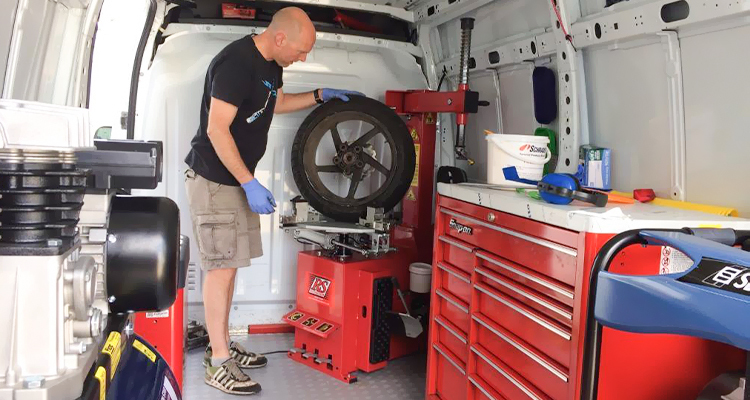Professional Mobile Tire Repair in Las Vegas - Rapid Service Assured
Professional Mobile Tire Repair in Las Vegas - Rapid Service Assured
Blog Article
Tire Service: Proven Techniques for Optimum Tire Maintenance and Treatment
From making sure correct tire pressure to routine turning and placement, there are proven techniques that can considerably extend the life-span of your tires and improve general driving experience. Allow's dive right into the world of tire service and find the keys to keeping your tires in top-notch form for the long haul - Mobile Tire Repair Las Vegas.
Relevance of Tire Stress
Proper tire pressure is an essential consider guaranteeing optimum vehicle performance and safety and security when driving. Keeping the advised tire pressure degrees offered by the producer supplies various advantages. Sufficient tire stress promotes much better gas performance, as under-inflated tires can lead to raised rolling resistance, creating the engine to work more challenging and take in even more gas. Right tire stress ensures even walk wear, improving tire longevity and conserving money in the lengthy run by delaying the need for premature replacements. Additionally, effectively pumped up tires add to improved handling and braking abilities, important for safe driving in various road problems. Over-inflated tires, on the other hand, can lead to minimized grip and a harsher adventure. Alternatively, under-inflated tires are vulnerable to overheating, which can result in blowouts and accidents. Frequently readjusting and checking tire stress, specifically soon journeys, is a simple yet reliable method to boost car efficiency, expand tire life expectancy, and prioritize safety and security on the roadway.
Tire Turning Standards
When taking into consideration tire rotation guidelines, it is essential to recognize the significance of this upkeep job in taking full advantage of tire lifespan and keeping optimal car efficiency. Tire turning entails transforming the placement of each tire on a lorry to make sure even step wear. Front tires have a tendency to wear a lot more quickly than back tires due to guiding forces, making normal turning vital for balanced wear patterns.

Benefits of Wheel Positioning
Making sure correct wheel placement after tire turning is crucial for maintaining balanced wear patterns and making best use of vehicle efficiency. In addition, appropriate wheel alignment helps to expand the life-span of your tires. Misaligned wheels can cause unequal tire wear, leading to premature tire substitute and raised upkeep prices.

Tire Footstep Deepness Check
Executing a regular assessment of tire step depth is vital for keeping safe driving conditions and lengthening the lifespan of your tires. The tread on your tires plays a critical role in supplying grip, specifically in unsafe or damp conditions. To inspect your tire step depth, you can utilize a walk deepness scale or the penny test. The recommended walk depth is at the very least 2/32 of an inch. It is time to replace your tires to make sure optimum efficiency and safety and security on the road if the tread deepness is listed below this limit. Irregular step wear can show concerns with tire stress, placement, or suspension, highlighting the value of routine walk depth checks. Overlooking to keep an eye on and preserve proper tread deepness can result in decreased grip, longer stopping ranges, and a raised danger of hydroplaning. By integrating tire tread depth look into your regular maintenance schedule, you can drive with self-confidence recognizing that your tires remain in leading condition.
Seasonal Tire Evaluation
Seasonal tire examination is a basic facet of tire maintenance that webpage makes certain tires are all set to encounter the obstacles presented by different weather conditions. In prep work for winter months, it is crucial to examine the tire stress consistently as cool temperatures can create tire stress to go down. By carrying out routine seasonal tire inspections, vehicle drivers can lengthen tire life-span, improve fuel efficiency, and most notably, make sure a protected driving experience in varying weather conditions.
Conclusion
Finally, maintaining correct tire stress, rotating tires frequently, lining up wheels appropriately, keeping an eye on walk deepness, and carrying out seasonal assessments are necessary techniques for optimum tire treatment. By complying with these verified approaches, chauffeurs can guarantee their tires last much longer, do better, and add to overall vehicle safety and security. It is very important to focus on tire upkeep to avoid crashes, improve fuel efficiency, and lengthen the life expectancy of tires.
Appropriate tire pressure advertises much better fuel efficiency, as under-inflated tires can lead to increased rolling resistance, causing the engine to function more difficult and eat even more fuel.When considering tire turning standards, it is crucial to understand the value of this maintenance task in taking full advantage of tire life expectancy and maintaining optimum lorry performance. Seasonal tire examination is a basic aspect of tire maintenance that makes sure tires are ready find out here now to encounter the difficulties postured by various weather condition problems. By performing regular seasonal tire examinations, chauffeurs can lengthen tire lifespan, improve fuel performance, and most significantly, ensure a safe and secure driving experience in differing weather condition conditions.
In conclusion, preserving appropriate tire pressure, turning tires routinely, lining up wheels appropriately, keeping an eye on tread deepness, and performing seasonal examinations are crucial practices for optimum tire care.
Report this page